Flooding in Oxfordshire: what can we do?
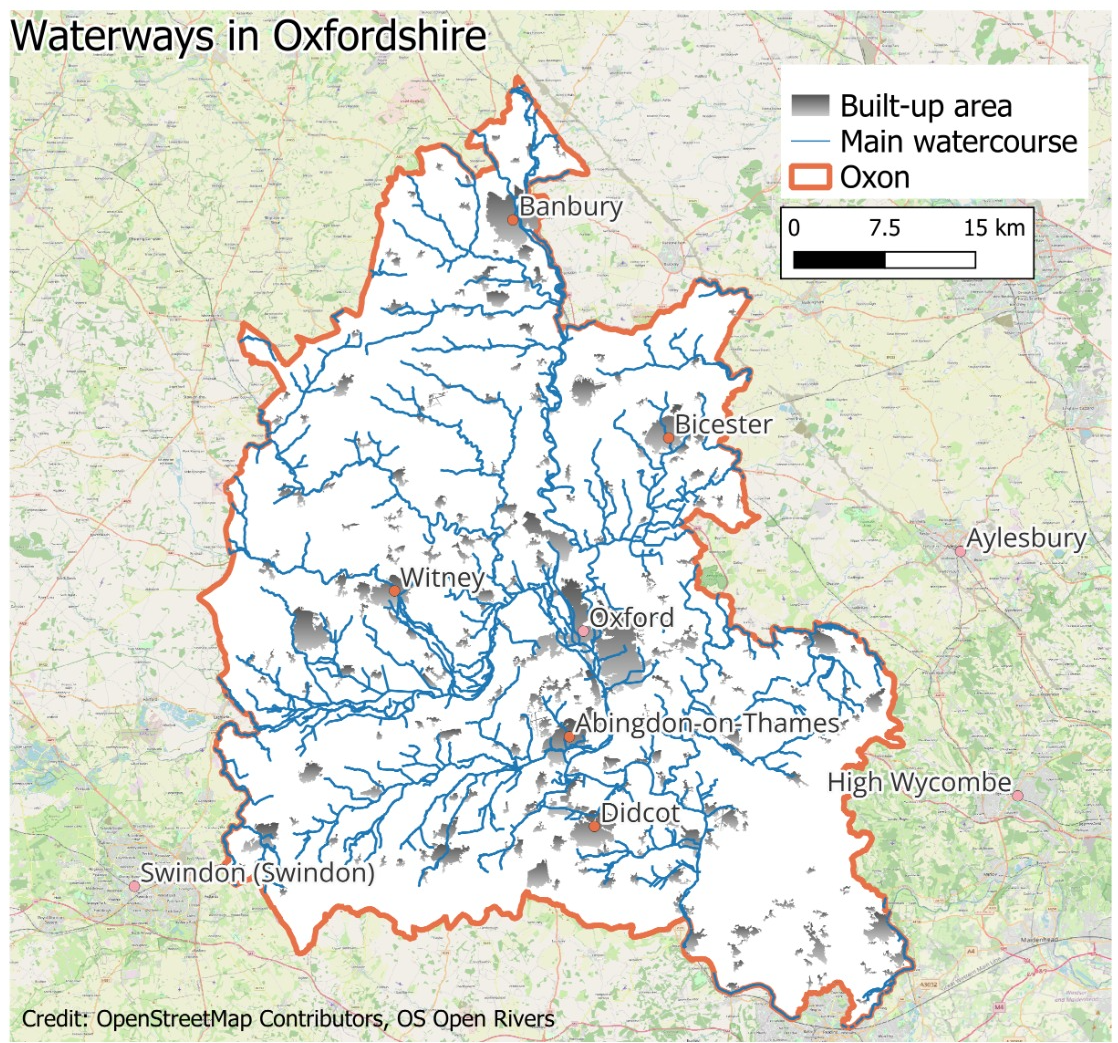
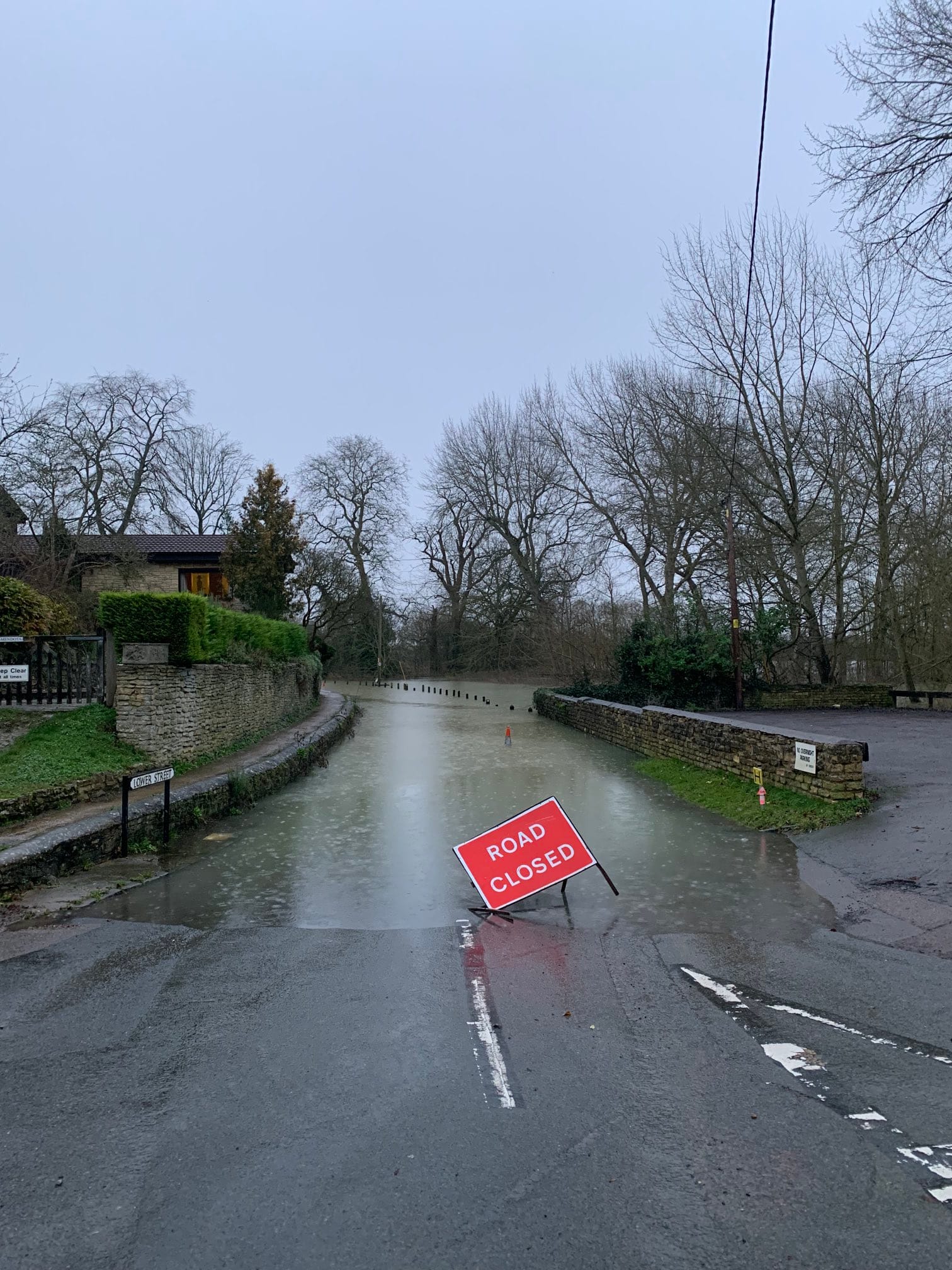
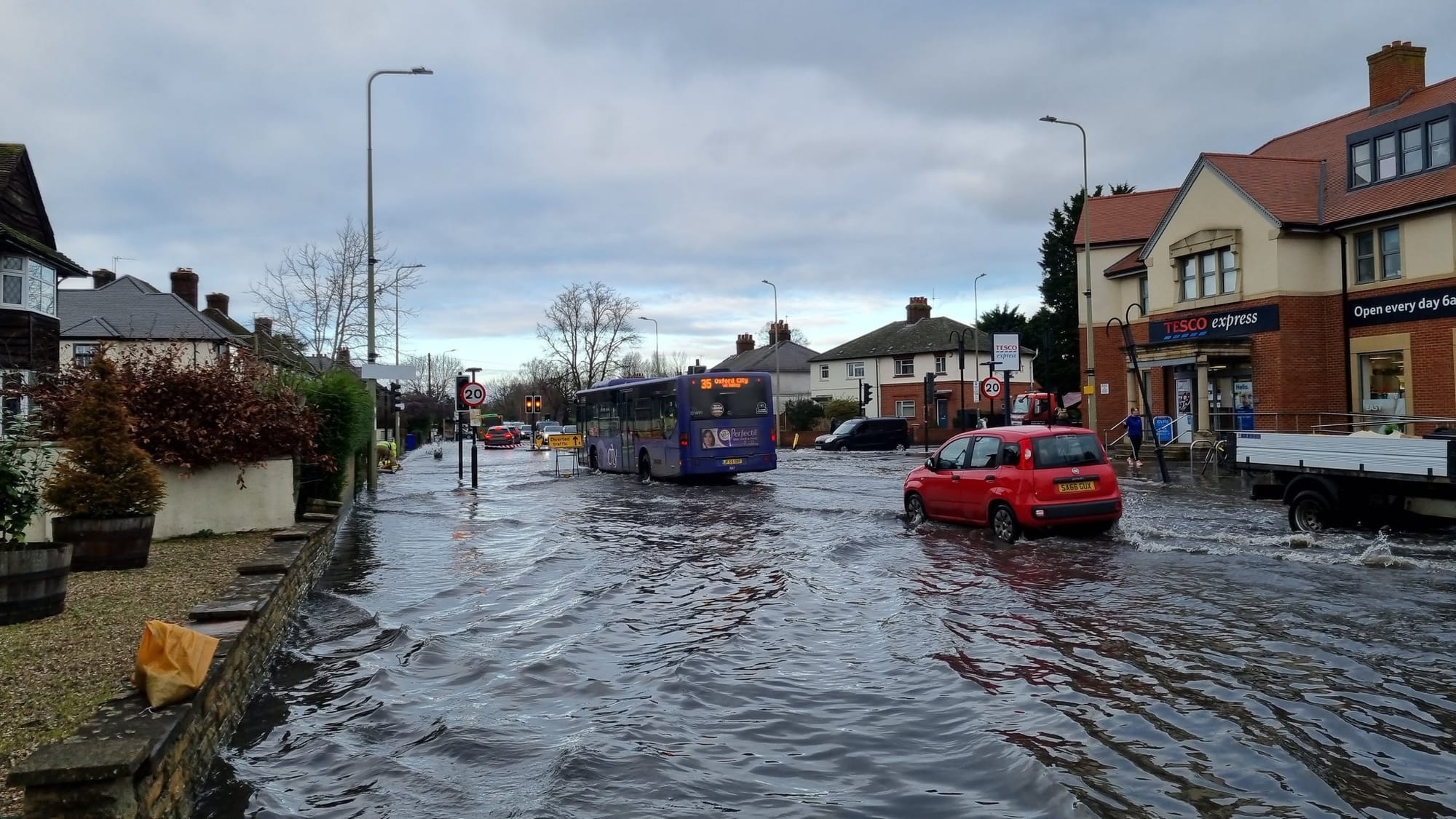
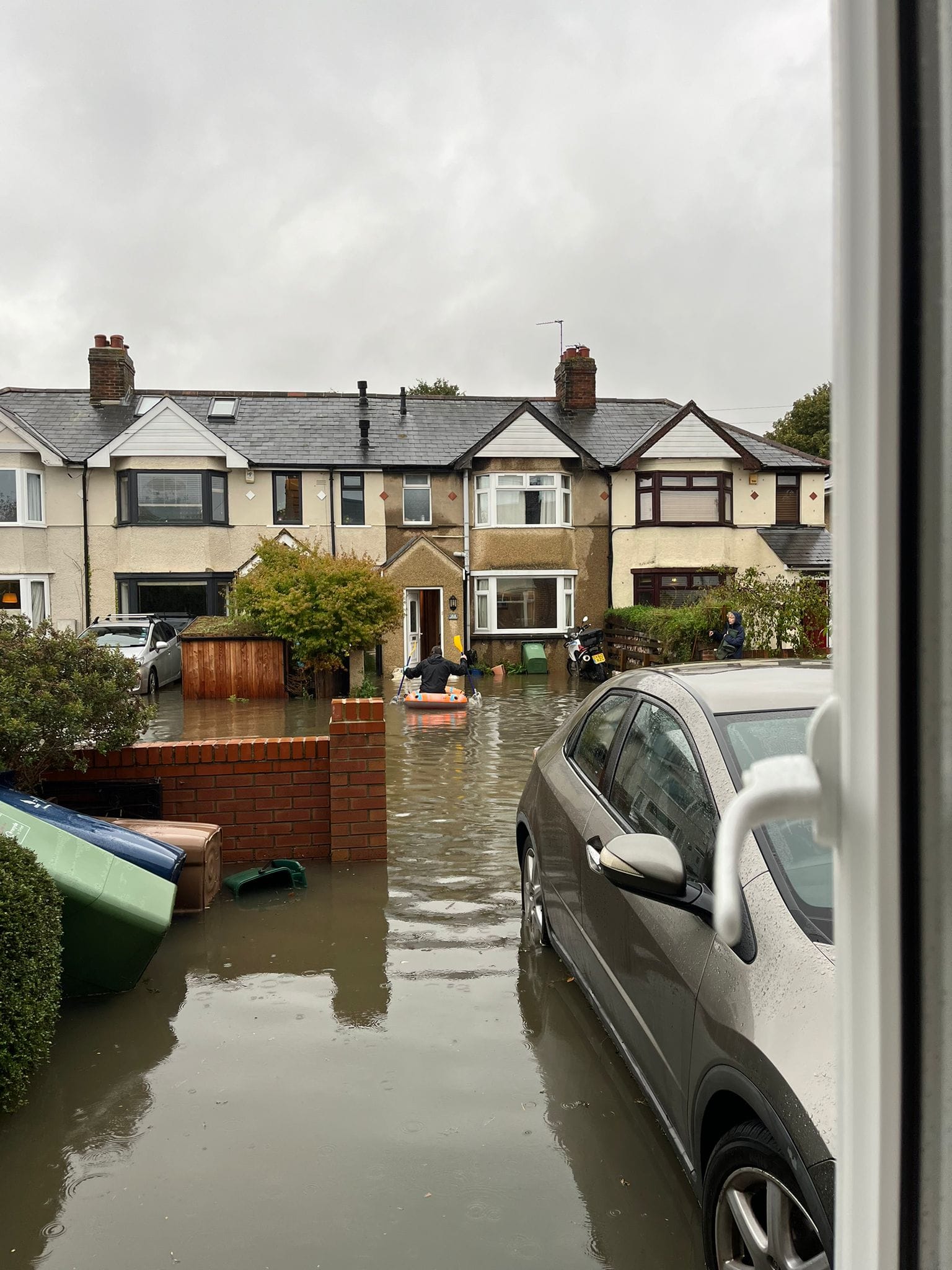
Flooding in Islip (William Whyte) and on Oxford's Abingdon Road this year (Anna Railton). A resident kayaks down Oxford East's Campbell road in October 2024 (social media)
Oxfordshire has a flooding problem – and it’s getting worse.
We are not talking Florida-style flooding. Oxfordshire is about as far as it’s possible to get from the sea in England – and although that didn’t help in North Carolina, the North Atlantic is nowhere near as hot as the Caribbean. What we do have is rivers, lots of them, and low lying ground.
September 2024 in Oxford was the wettest month in 250 years. Flood prevention measures in the city since 2007 have alleviated some of the worst flooding around Osney, for example. But other parts of the town and county found themselves under some very murky water last month.
Is resisting the waves a futile Canute-like endeavour? Is it all down to the council, or can individuals make a difference? Are the floods really more frequent now? Or should we all simply move to Cumnor Hill? We took a look at the detail and spoke to Councillor Pete Sudbury, Deputy Leader of Oxfordshire County Council.
Why is Oxfordshire so prone to flooding?
Oxford was built at the heart of a complex river system containing seven catchments. The Cherwell flows into the river in central Oxford, the Evenlode and Windrush just upstream. They, in turn, have absorbed long tributaries such as the Ray and Glyme, and a host of brooks winding in and around suburban Oxford, Headington and Marston/Marsh Town. (Headington Heritage writes about this in fascinating depth.)
The Thames itself splits into countless streams through West Oxford: Botley, Bulstake, Seacourt. The ‘-ey’ in placenames such as Osney and Botley shows they developed as islands in the marshy, flooded riverlands. Tens of thousands of years of shifting river beds have given us the low-lying landscape that characterises Oxford.
But as Cllr Sudbury explains, Oxfordshire’s floodprone nature cannot solely be laid at the door of the shifting Thames.
Not only are we prone to flooding due to our natural geography, but on top of that, the county has lost historic riparian forests and flood meadows, often to development, leaving little leeway to hold water back and allow it to flood naturally, and accelerating runoff into remaining channels. Farming has changed over time from pasture to arable land with lower soil carbon. This means slower absorption of rain and less holding capacity, leading to much more rapid runoff vs land used for grazing livestock.
And we have to look at climate change as a major factor. 1°C warmer ocean surface and air above it means 8% more water vapour, plus increased energy into the clouds when it condenses – meaning raindrops get bigger, rainfall more intense, and total rainfall higher.
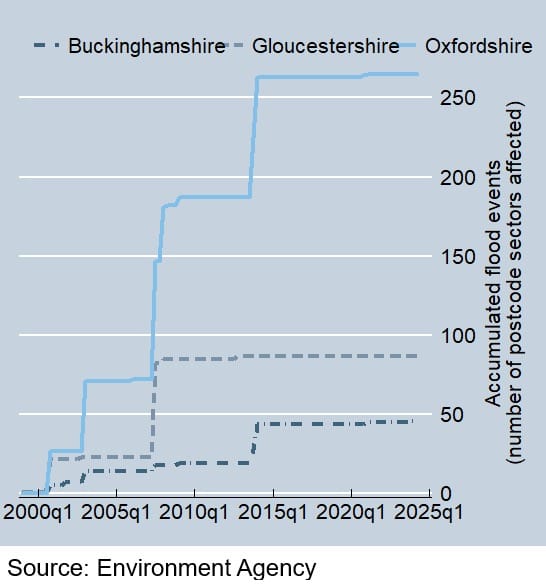
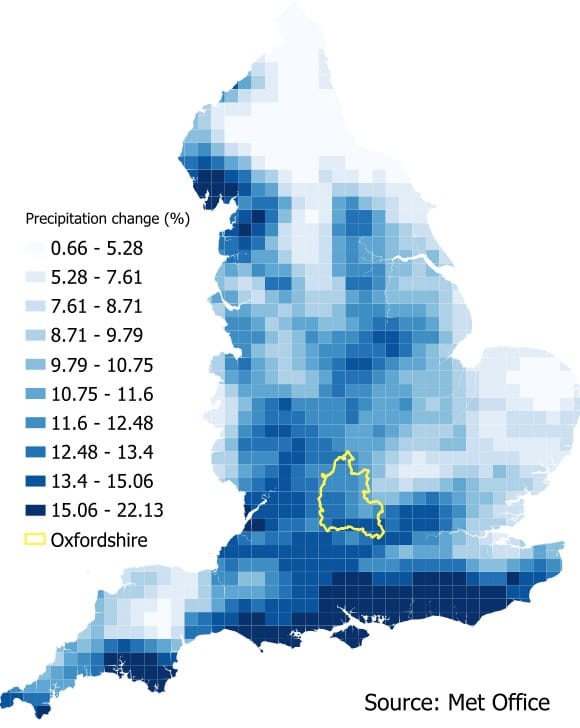
Records show that floods are now more frequent than they were 40 or even 20 years ago. Oxfordshire had not always been the worst affected, but in recent years, it has far outpaced its neighbouring counties. Cllr Sudbury says we should look to the climate for an explanation.
Climate change just stepped up a gear. The temperature of the surface water in the North Atlantic, where our weather comes from, has jumped more in the last 5 years than the previous 20. That is like pressing “fast forward” to what we could have expected in 2040, and it's likely to continue to run ahead for several years to come.
We've seen hideous storms in North America (fueled by North Atlantic and Caribbean heat), Europe (fuelled by water even hotter than the Atlantic, in the Mediterranean and Black Sea), and here – where September rainfall across the middle of England was in places over three times what we'd normally get, with most of that in a week towards the end of the month. We have to accept the high probability that it's not a freak year, but a new normal.
Who can fix it?
Climate change is a global challenge and a local responsibility. But even in Oxfordshire, local responsibility for flooding does not fall on just one body.
Thames Water is responsible for drainage. Most drainage, whether it is your kitchen sink, your toilet or the drains in the road, goes in to the sewer system somewhere. If the sewer is blocked with a fatberg [do not click this link if you're reading this over dinner], or has sediment in it, or leaks, then intense rainfall will overwhelm the sewage system and cause flooding with the euphemistic “foul water”. Which is, on many levels, literally shit.
The Environment Agency is responsible for managing the risk of flooding from “main rivers”, issuing flood warnings, and providing information through flood risk mapping. It is also responsible for operating and managing flood defences, normally located on main rivers, such as those at South Hinksey and Osney Island.
Oxfordshire County Council is responsible for fixing drainage and flooding issues on highways and roads across Oxfordshire. This includes blocked drains and gullies. Ditches alongside roads, however, are often the responsibility of the adjacent landowner. OCC is also responsible for coordinating the management of flood risk from surface water, groundwater and ordinary watercourses. This does not mean that they can or will undertake works to fix a flooding issue; but they can investigate to find the riparian owner (the landowner beside a watercourse), who is responsible, and advise on potential solutions.
Oxford City Council, and the four rural district councils, are major landowners. They maintain the watercourses where they have ‘riparian responsibility’ from adjacent land ownership. The work includes clearing vegetation from banks, removing silt from channels and keeping grilles clear where watercourses enter culverts. They, too, can ensure that similar work is done by other landowners. In Oxford specifically, the City Council’s works arm ODS has particular experience in erecting flood barriers.
None of the three public sector organisations are flush with funding, and Thames Water’s finances are a story in themselves. As Cllr Sudbury explains, flood defence budgets are extremely stretched.
This extreme weather comes at the end of over a decade of austerity, with staff numbers in local government and the Environment Agency half what they would have been a decade ago. Even with “all hands on deck” there aren't really enough bodies to go round when a really big emergency happens.
We also need to face up to real problems with infrastructure. This is partly from a decade of underinvestment by government and also by water companies busy putting shareholders before bill-payers. But it is much more problematic than that: even if all the drains, pipes, gullies were in perfect condition, they are obsolete, designed for the weather conditions of the last few thousand years, which we have now left and will not see again in a human lifetime.
What is being done?
Oxfordshire’s biggest single answer to flooding is the Oxford Flood Scheme, led by the Environment Agency. This huge investment in flood prevention will create a new stream (with wetland wildlife corridor) to the west of Oxford to reduce flood risk in the city and surrounding areas. Its aim is to reduce flood risk to those 5,600 properties in Oxford forecast to be at risk of flooding – as well as to the railway, roads such as Botley and Abingdon Road, and utilities and services such as broadband. The stream and lowered ground alongside it reduce flood risk by creating more space for floodwater, away from built-up areas.

Its journey through the planning system has been typically tortuous, but the channel was granted planning permission earlier this year. Once it has been signed off by Government and compulsory purchase powers agreed, construction could start in 2025, taking up to five years.
This is a £176m project. Not all flood prevention work need be so expensive. Sometimes, minor interventions can solve localised flooding issues. Cllr Sudbury again:
At OCC, we've already invested in strengthening our flood team and investing in clearing ditches and drains. Our climate work means we have the best possible information on risks of flooding and extreme heat, mapped at fine detail across the whole county.
We and our partners know where the best places are to put trees, or rewild, or strengthen natural flood defences. We will be stepping up spending on flood management and on working with communities, as we have with a very successful "Flood Wardens" scheme. Our resilience (emergency planning) team will provide help for any parish/town council or similar body to put together an emergency plan for how to deal with flooding and all the other potential climate emergencies.

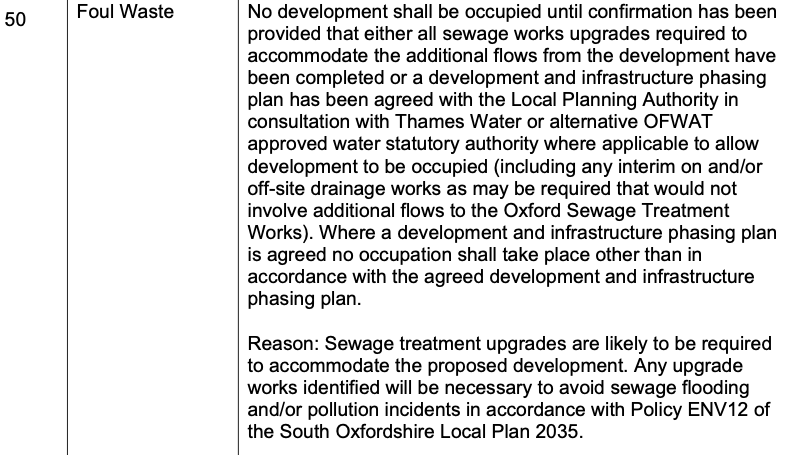
Bayswater Brook development near Barton, and the provision for sewage imposed by the planning authority
But with 100,000 more homes set to be built in Oxfordshire, flood defences will have to run just to stand still. New roads, driveways and public spaces will all impact on the county’s watercourses as the rains fall.
Sewage is the flashpoint. At times of flood, Oxfordshire’s sewage works cannot cope, and overflow into the Thames into its tributaries. The Environment Agency says the situation must not get any worse – which means if Thames Water does not act on sewage, development will stop.
The Boundary Brook development (pictured) will not be completed until Thames Water have confirmed an upgrade to the Oxford Sewage Treatment Works. The potential impact on Oxford is such that Susan Brown, leader of Oxford City Council, took the unusual step of publicly calling for action over the lack of investment.
Modern developments are more flood tolerant than they were in the 1980s and 90s. But Cllr Sudbury says we still have some way to go.
We do have to get all of our drainage systems working as best they can, but that may be a two-edged sword: getting extreme rainfall into rivers may just flood the places downstream. We need to rework the whole way we manage water, from the moment it falls from the sky, to the time it reaches the sea. We need to hold water back at every stage, spreading out the sudden flows of water that cause so much damage.
Belts of trees, ponds and dykes or ploughing along contour lines, whilst also improving the soil so that it soaks up water can all help. “Rewiggling” rivers and streams, and restoring riparian woodland, marshes and flood plains around them slows down and evens out the flows towards towns and villages. Within built-up areas, we can replace hard and impermeable paving with grass or rain gardens, we can plant trees or shrubs right by the road with their roots open to water flowing down the gutter. We can “deculvert” streams, so they can handle a lot more water, and channel water flooding down streets so as to keep it out of harm's way.
Communities, or even individuals, can make a difference here. Each parish in the county is being encouraged to draw up a flood preparedness plan. This might be agreeing local vegetation clearance by volunteers, or checking drains, or it might be having sandbags or flood barriers stashed and ready. It might be a plan to check up on vulnerable residents. Or it might be all of the above. The Oxfordshire Flood Toolkit gives details of how communities can help be prepared for flooding and what resources they can access.
What can you do?
If you are a riparian owner – that is, you are fortunate enough to own a home with a watercourse that in summer is a glorious babbling brook or and (we quote) “beck, ditch, stream, leat, goyle, rhyne, or culvert” (did they make some of these words up?), do check out your responsibilities. Clear the vegetation; let the water flow; remove any dead trees and debris.
Residents in places such as Osney Island and Islip have grown used to water lapping at their doorsteps. But with the increasing frequency of floods, more houses are affected every year. If you think yours might be at risk, there are many ways you can protect it – some more obvious than others.
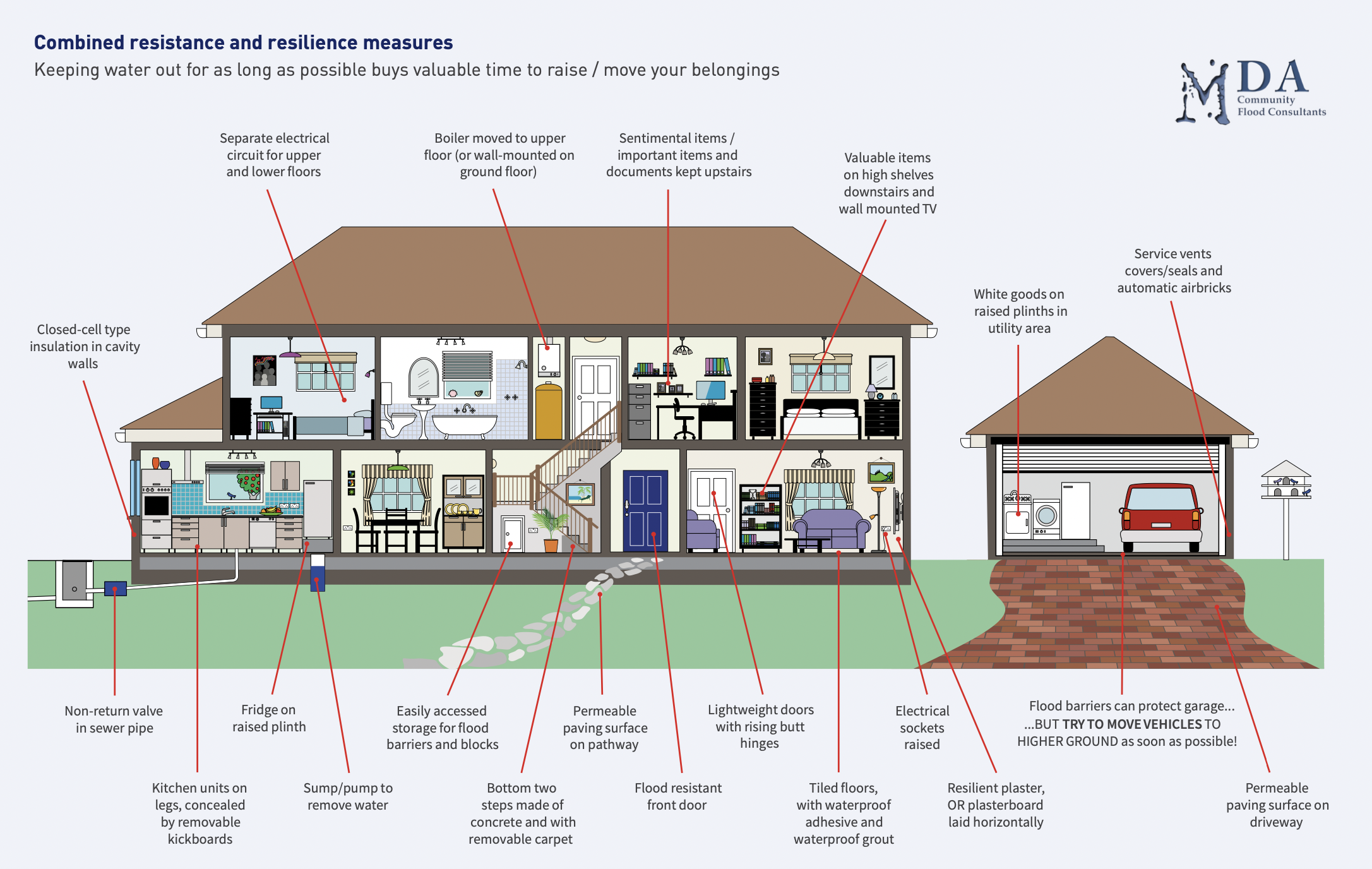
But it goes deeper than that. We have already established that Oxfordshire floods. Each and every property owner in Oxfordshire can help by considering the land they own. Is it a concrete jungle? Front garden all paving slabs; astroturf; or permeable paving? Is there a well maintained lawn? Trees and shrubs that can absorb water? Are you harvesting rainwater in times of flood to water your garden (or even your home) in times of drought?


A 'garden' laid with paving and artificial grass of a house currently for sale in Summertown vs a 'flood resilient garden'
It is understandable that many residents do not want to think about this. They want “the council” to sort it out for them. Every time flooding is reported, social media is full of comments about councils not spending money on flood defences or dredging drainage ditches. Cllr Sudbury, however, argues that working together will actually result in better results than relying on cash-strapped councils alone:
People have talked about (and worried about) climate change for a long time. It begins to feel like we've left that stage behind. Climate change is here, it's real, it's dangerous and we need to get one step ahead of it and stay there for the 30 or more years it will take to stop burning fossil fuels and start getting the temperatures back under control.
But it's not all “blood, sweat, toil and tears”, though it will in some ways be like a long war. Many of the things we do – “de-paving” streets, putting in rain gardens or rainwater ponds, de-culverting streams, planting trees and shrubs in towns or in belts across hillsides, restoring flood meadows – will make our lives better, with the natural world in the places we live, and the countryside more verdant and beautiful. Taking action house by house, as well as in every bit of land or water leading to them will let people sleep easy at night, free from the dreadful fear of having your life turned upside-down by the weather. Most of this would be worth doing for its own sake. We now have an urgent reason to do it sooner.
Climate change is not going away. We all live in this county and have a responsibility to each other. On an individual level we can consider our gardens, the way we live, and how much carbon we push into the atmosphere by travelling and heating our homes.
We doubt Rishi Sunak gave Oxfordshire’s watercourses a thought when he called a General Election for May 2024. (Or maybe he did?) But they turned out to be a pivotal issue. As the national media focused on immigration, the economy, the health and cost of living, voters in Oxfordshire – a county literally defined by its rivers – pressed would-be MPs on what they could do about sewage.
Flooding was once a rare occurrence. This year it has come home to the residents of Oxford, Witney, Banbury and elsewhere. Perhaps the challenge is to stop thinking about flooding passively, as something that simply happens to us – and realise that it is something we affect, through the way we live our lives and the politicians we elect.
Further reading
- Oxfordshire Flood Toolkit
- Preparing for emergencies: Thames Valley Local Resilience Forum.
- Planting to reduce flood risk: Royal Horticultural Society
We are indebted to Cllr Sudbury who has worked with us on this patiently. We would also like to thank a new collaborator, a data scientist who supported us with some of the information here. We are all the Clarion,
